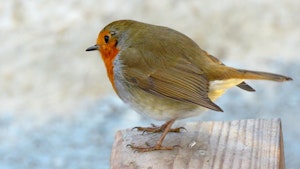Get to know your (wildlife) neighbours
We don’t always notice the comings and goings of the little creatures who share our world, but if we stop and wait quietly we can start to get to know our wildlife neighbours.
WHAT YOU MIGHT SEE
- Birds like robins and blackbirds have very defined territories, so if you spot one or both of these regularly they could be your neighbours.
- Small mammals build tunnelled homes underground but come out to forage for food and water. They can be very shy so you will have to be very quiet to spot them.
- You might encounter a wide variety of insects, from visiting bumblebees to woodlice, ants and beetles. There are 27,000 species of insects in the UK, how many will you spot?
WHAT YOU WILL NEED
- Binoculars (if you have them)
- Magnifying glass or bug pot (if you have them)
- Free, downloadable ID sheets (Sheet 1, Sheet 2)
- A notebook and pen
- DIY quadrat (instructions in CAT’s ‘Make your own quadrat’ activity)
STEP BY STEP
1. Find your nature spot
Choose a spot in your garden or at your window. Your spot should be as quiet and peaceful as possible but big enough that you can observe nature without disturbing it. Is there a tree near your house that you can see? Or maybe there is a hedgerow or overgrown space to watch?
2. Practise sitting quietly
I know it sounds silly but stopping and being quiet is not always as easy as it sounds. Make sure you’re comfortable, take a cushion or seat with you and practise sitting and observing for one minute.
How was that? Can you increase your time?
3. Create a nature watching schedule
Choose a nature spot you can visit regularly. Try to spot any patterns or habits from the wildlife that lives or visits there.
Can you notice a difference in the activity during the morning compared with at lunchtime? Who is out and about at different times of day?
4. Prepare your equipment
So that you don’t disturb the wildlife, make sure you have everything you need within easy reaching distance (you don’t want to scare away your wildlife neighbours when you reach for your binoculars).
5. Get tracking
Can you make a wildlife diary of your observations? You can bring it to life with notes, drawings, pressed plant specimens, hand-drawn maps of your spot, as well as the data that gives your observations scientific relevance (date, time of day, season and weather).
If you’ve made a quadrat (see CAT’s ‘Make your own quadrat’ activity) or if you’ve got binoculars, a magnifying glass or bug pot you can use them to get a bit closer to your wildlife neighbours.
If not, don’t worry, you can observe a lot by using your senses. In your field notebook can you write down at least one thing you have noticed when using your senses? Sight, sound, touch (be very careful here), smell. To get even better results from using your senses for observation take a look at CAT’s ‘Sensory explorers’ activity.
6. Review your findings
After a week of careful observations can you go back through your field notes and draw any conclusions about your wildlife neighbours’ habits?
Is your spot abundant in a certain insect? Think about why they’re there. Is your spot an excellent food source for pollinators? Have you seen the same bird or mammal appearing again and again? Could they be your wildlife neighbours? Collecting data about the natural world is all about asking questions.
What have I noticed?
Have I noticed this before? Is there a pattern?
Has something changed for some reason? Is the weather cooler today? Is it a different time of day?
Can I predict what might happen tomorrow?
7. Share your findings
To share pictures of your work, post them on CAT’s facebook page or tag @centreforalternativetechnology on instagram. #CATatHome
EMAIL SIGN UP
Keep up to date with all the latest activities, events and online resources by signing up to our emails and following us on social media.

